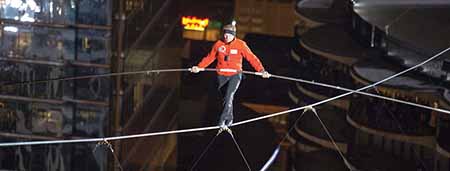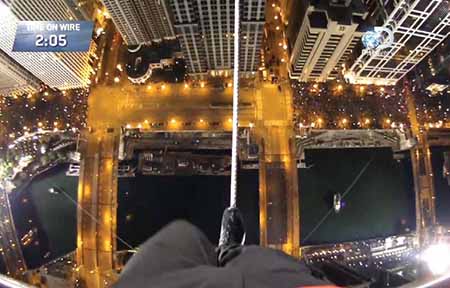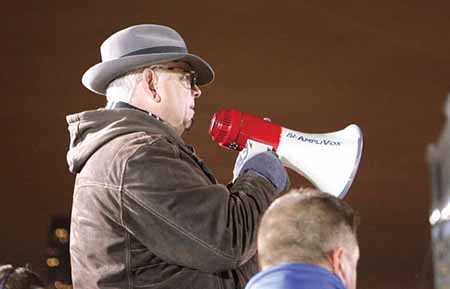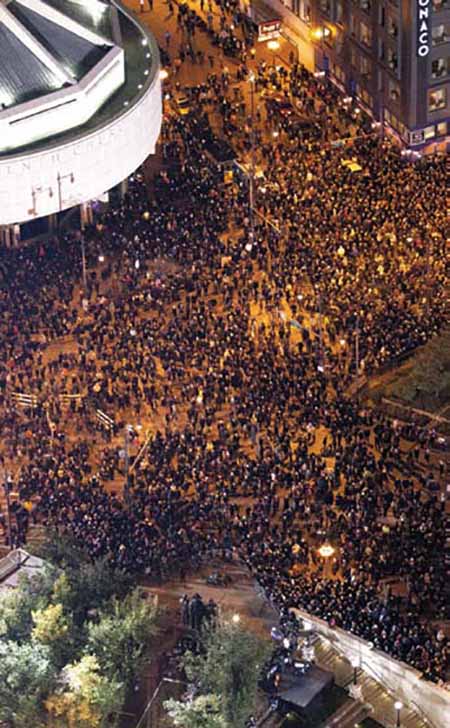Technology Takes a Tightrope Walk

CHICAGO—As a man prepared to walk off the edge of a skyscraper and on to a 340-foot-long steel cable, Marc Weinstock had other things on his mind.
While 65,000 people on the ground and more than 6.7 million viewers were watching daredevil Nik Wallenda walk untethered across a tightrope over the city of Chicago, the director of technical operations for NBC’s field and production operations had his mind on technical things. Weinstock was part of the two-department NBC team that was producing the event for the Discovery Channel. And as such, they’d strung 1,500 feet of fiber up and down buildings, set up 22 cameras and rigged a POV camera on Wallenda himself to catch his attempt to break two Guinness World Records: the world’s highest incline tightrope walk, and the highest tightrope walk while blindfolded.
CHALLENGING LOGISTICS

Nik Wallenda wore a proprietary 1080i mini-POV camera custom designed by Broadcast Sports inc. on his vest to give a unique point of View. This isn’t the first time that Weinstock and his team watched the tightrope-walking Wallenda attempt a seemingly insurmountable feat. Last year, Wallenda attempted an untethered 1,200-foot walk across the Grand Canyon. Even though the broadcast team was not setting up in a cavernous canyon in the middle of the desert, Chicago had its own set of challenges.
“This year’s show in Chicago was certainly different [from the Grand Canyon], but we had a lot of the same production team in place, and that helped make things run more fluidly,” Weinstock said.
Chicago had its own share of challenges—no small part because this crowded, busy metropolis didn’t slow down just because a tightrope walker was balancing with pole and his wits some 600 feet in the air.
“The challenges were dealing with permission and rights and with the building itself,” Weinstock said. “We had to make sure that our structural engineers weren’t putting things in places that they didn’t belong.” That’s where the fiber came in. The team—comprised of the NBC technical support team and Peacock Productions, the network’s reality and documentary production team—worked with Sea to Sky Cable Cam Inc. to deploy more than 1,500 feet of fiber in the city, going so far as to literally string fiber up the side of buildings, down to the production trucks and across to three towers.
Get the TV Tech Newsletter
The professional video industry's #1 source for news, trends and product and tech information. Sign up below.
One of the biggest challenges came on the Friday before the event when the weather turned foul, with winds over 60 mph on the rooftops putting all the rigging and rooftops technology to the test. Yet it all came through without so much as an untied wire. “That really showed how good the quality of the fiber was; all of that was blowing around and chafed up the side of the building. But we lost no strands,” Weinstock said.
The NBC team placed that much faith in the technology because of its ongoing track record. “We gained a lot of confidence in fiber technology,” Weinstock said. “We used backup RF systems in the Grand Canon because we were concerned fiber would break. [This year] we relied entirely on it. That is the only way to go, for all of our data, communication and cameras.”
Weinstock pointed to fiber’s flexibility during the Wallenda production, including its ability to handle full bandwith HD, and to handle wireless communications. “Because the crowd was so big, the cellular networks were crushed a bit,” he said.
Setting up those rigs was a technical feat in itself. A helicopter was able to pull up some of the rigging lines that would hold the cable cam, but it wasn’t easy, said Matt Maddaloni, CEO of Sea to Sky Cable Cam Inc., a Vancouver, B.C.-based provider of point-to-point cable cam systems. “For one thing, helicopter companies are not used to pulling lines a long distance like that, they’re used to pulling straight up and down,” he said.
The team was also tasked with physically hauling one of the cables using their own hands when using the helicopter wasn’t an option. “We had to lower ropes the height of the building down to the ground, and one day before the event they had 65 mph winds,” Maddaloni said. “We were quite concerned about lowering ropes down 700 feet because they can wrap themselves around the building, smash into glass or wrench items off the building.”
GETTING GEAR IN PLACE

Terry Troffer helps his son Nik Wallenda as he walks across the Chicago skyline blindfolded for Discovery Channel’s Skyscraper Live with Nik Wallenda on Nov. 2. But the effort was worth it, he said. “The number one reason that we were being hired was to have a high-speed camera over a long distance so you get a lot of parallax [between Nik, the buildings and the camera],” Maddaloni said. “As Nik is walking the line, you see the building spinning past him in the background. Helicopter cameras can do that, but a drone can’t carry that high-speed of a camera, and the wash from a helicopter would blow Nik off the line.”
Getting other gear in place was another hurdle. The production team heli-lifted a large majority of necessary broadcast gear up to the top of the three skyscrapers: the two Marina City Tower buildings and the Leo Burnett Tower. Where in the Grand Canyon, the starting line was a rock in the middle of the canyon; in Chicago the team faced similar challenges: the freight elevators were too small to handle the power transformers and production gear needed to support the broadcast. A helicopter team from Midwest Helicopter Airways flew 15 lifts to the observation decks of the three towers, installing lines between the tops of the three riverfront buildings so that a Sea to Sky cable cam could ride the cable and follow Wallenda as he walked first from Marina City to the Leo Burnett Building, and then to Marina City’s west tower, which he managed blindfolded.
Back on the ground, the NBC team operated within the 53-foot Amazin’ expando production truck from Game Creek Video, which included a Grass Valley Kayenne K-Frame production switcher, Calrec Artemis surround sound console, Evertz audio and video routers and EVS replay servers.
“Urban locations always provide a unique challenge,” said Riley Helsen, production engineer with Hudson, N.H.-based Game Creek Video, who worked the Wallenda event. “We are trying our best to squeeze mobile units in on narrow streets and set them up in a location that is not catered to television production.
“In a show like this in Chicago, everything we take for granted in a pre-cabled venue has to be built and wired from the ground up,” he said.
The biggest challenge at this event was providing Evertz router control, RTS intercom connectivity and general network infrastructure to the three rooftop footprints that NBC had built on top [of the buildings], Helsen said. “Since these locations are 650 feet in the air, they’ve got to function perfectly from the moment they’re set up,” he said.
The team used 22 cameras on the main show with a complement of Canon and

An estimated crowd of 65,000 watched from the ground as Wallenda walked untethered across a tightrope strung 600 feet over the city of Chicago. Fuji lenses on a battery of Sony HDC-2500s and Sony HDC-P1 on the cable cam that slid down the companion wire to follow Nik as he began his walk. The HDC-P1 was also used for the production’s steadi-cam shots and as the onboard helicopter camera. According to producers, the program was on a 10-second delay managed by Discovery’s network operations center in Sterling, Va., and the production staff onsite had a very detailed protocol document in place should anything unexpected have happened.
POV CAMERA
Perhaps the most compelling images (or nauseating, depending on your fear of heights) came from a proprietary mini-POV camera strapped to a vest worn by Wallenda during his walk. Custom designed by Broadcast Sports Inc., the 1080i mini POV gave a realistic point-of-view shot of Wallenda as he took his first step off of the building onto the tiny steel cable, his toes gripping the wire. “We wanted to come up with something that showed what was happening from Nik’s point of view,” Weinstock said.
The production team included the main broadcast production, which was produced by Peacock Productions and aired on the Discovery Channel; and a team from NBC’s digital online group, which set up a studio at ground level with five on-the-ground cameras and produced a companion show that aired online.
“They had the ability to get other cameras on their six-channel stream,” Weinstock said. “When we were on commercial, their programming picked up. The goal was to drive traffic between both streams so that [viewers were] always connected. It was a good opportunity for two platforms to share resources.”
Like many live television shows, “things are always up to the wire, and don’t work exactly as we hoped, especially with all that bad weather,” he said. But by Saturday things started to sync up, and by show time, everything was as running exactly as planned, he said.
“Because of all of the planning we did beforehand—the meetings and conversations and drawings and paperwork—when we stood there on show day, 95 percent of it went as planned, and that’s what helps things go smoothly,” he said.
Particularly when you’re 50 stories in the air.
Susan Ashworth is the former editor of TV Technology. In addition to her work covering the broadcast television industry, she has served as editor of two housing finance magazines and written about topics as varied as education, radio, chess, music and sports. Outside of her life as a writer, she recently served as president of a local nonprofit organization supporting girls in baseball.

